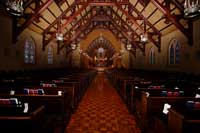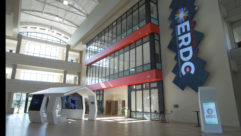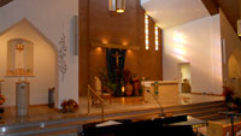

Product at Work: Tannoy QFlex
Feb 14, 2012 11:30 AM
Two congregations—one in Portland, Ore., and one in Santa Fe, N.M.,—sought to fill their historic churches with the fullness and clarity of sound that modern arrays can deliver. In both cases, the churches could afford to be selective and auditioned several speaker options before making their choice. Beyond sound quality, simplicity and aesthetics factored heavily, as they so often do in historic churches.
Part of the mission at Portland’s Trinity Episcopal Cathedral is accessibility and ease, defined by a 172-year commitment to serve all people, regardless of faith, sexual preference, or ethnicity. Clear, natural sounding reinforcement of speech was a priority in its almost 1,000-capacity sanctuary. Steve Jellerson, senior consultant/design engineer and founder of Portland-based Delta AV, has roughly 1, 000 church installs under his belt and describes Tannoy as one of Delta AV’s go-to solutions for a variety of applications. “Frankly, it’s the one we go to when the client says we want better and we’ve got money,” he says.
The Trinity design/build, however, was Jellerson’s first experience with Tannoy’s QFlex. Being unfamiliar with the product, the choice was a leap of faith, he says—albeit one based on Tannoy’s reputation and the similarities between their approach to creating audio solutions and Delta AV’s in implementing them. Head Sexton Kimberly Sherwood functions as Trinity’s facilities manager. “Keeping everything functioning as far as the non liturgical side of the church business goes,” as she puts it, and she worked closely with Jellerson and Delta AV project manager, Michael Sanders, on the project.
As is often the case in house of worship installs, the primary challenges at Trinity were a matter of remaining conscious of the client’s aesthetic considerations while overcoming the problems of a highly reverberant space. “It’s literally an organ chamber,” Jellerson says. In fact, Trinity Episcopal houses a world famous Rosales organ, built specifically for the church and installed during a comprehensive renovation of the nave and sanctuary in the 1980s. “It’s roughly a 6-second RT, so the organ and the choir sound gorgeous, they don’t even mic them.”
While providing a system that was easy to operate was a key component of the design/build, intelligible reinforcement of speech was the number-one criteria. To serve Trinity’s needs, Delta AV’s design called for one QFlex 40 to be installed dead center on the sanctuary’s front arch, with the bottom of the array approximately 28ft. in the air. In this case, even as compact as QFlex is, Jellerson says, getting the system mounted was still a challenge. “We couldn’t use a lift, so they had to build scaffolding to get the system in, but it worked,” he says.
Control of the system is managed exclusively via a wireless AMX touchscreen. Post install, Jellerson explains, it was actually necessary to actually limit the amount of control the client had even further than they’d initially intended to. “We started out giving them too much control, so we ended up taking all that control away; now they just have volume controls that go plus or minus 3dB,” he says.
While the previous system, a mix of long- and short-throw horns, had worked reasonably well, it never provided smooth coverage front to back. “That’s where the QFlex stands out,” Jellerson says. “It’s a long seating area, approximately 75ft., and it stays within 1dB front to back.”
To achieve that, the church took a novel approach to tuning the system. “They stopped the Sunday service with a full house and had people on every microphone—five wireless, a podium and a pulpit mic, all Audio-Technica 4000 series—and had them speak one at a time,” Jellerson says. “They told everyone to stay seated unless they could hear perfectly. We went through every microphone, and we didn’t move on until we had everything the way they wanted it. That’s an unusual way to sound check. I’ve never seen a church do that before, but it worked and we got everybody standing.”
While unusual, Sherwood feels it was a necessary exercise. “We have five priests every Sunday, and they all have their own wireless microphones and there’s a lot of fine tuning to get everyone’s just right. We could have tested it all week long, but as soon as you put people in the cathedral, the sound changes, so we had to do it that way,” he says.
The result speaks for itself. “It’s worked out so well. The choir had never been able to hear themselves sing before. Now they can record and hear how they sound and that is just a joy for them. And I’m very happy with the main speakers. I’m amazed at how small they are and how much power they have,” he says.
Product at Work: Tannoy QFlex
Feb 14, 2012 11:30 AM

Home to one of the oldest Catholic congregations in the United States, the Cathedral Basilica of St. Francis of Assisi is sometimes referred to as the heart of Santa Fe, and for good reason. Although the Cathedral Basilica was dedicated in 1887, the site has been a focal point of worship for the community since 1610. The first church built where the current structure now stands was destroyed during the Pueblo Indian Revolt of 1680, but was rebuilt in 1714; a portion of which still stands within the existing building—a small adobe chapel dedicated to Our Lady La Conquistadora, housing the oldest representation of the Virgin Mary in the nation.
In addition to serving the spiritual needs of its own congregation, the cathedral Basilica’s rich history attracts approximately 100,000 visitors annually. As beautiful as the cathedral is, however, for some years it has had a problem, says Wanda Vint, director, development and donor relations at the Cathedral Basilica. Put bluntly: “You couldn’t clearly hear the word of God.”
That changed last summer with the installation of a state-of-the-art sound system that depends heavily on a pair of Tannoy’s QFlex digitally steerable column arrays.
The system was inspired by a 2009 visit made by the cathedral’s Rev. Monsignor Jerome Martinez y Alire to the Basilica of Saint Mary in Minneapolis, Minn. Surprised that such an old and similarly acoustically reverberant space could sound so good, he asked who had designed and installed the system and was referred to Minnesota-based, Audio Video Electronics (AVE).
The project that initially caught the monsignor’s ear was undertaken before QFlex was available, explains Kevin Crow, AVE’s VP of sales and marketing, but both spaces had similar issues: In the Cathedral Basilica of St. Francis of Assisi, the RT was 5 to 6 seconds in the mid-frequency band.
In order to meet the Cathedral Basilica’s needs, Stefan Svard, AVE president and system designer, specified a pair of Tannoy QFlex 40s. Placed on a pair of columns roughly 6ft. above the floor just in front of the altar, the QFlex provide coverage to approximately 75 percent of the 1,200-capacity, 90’x65’ space. They also provide low-frequency support throughout the nave, the south transept, and the Our Lady La Conquistadora chapel. (Additionally, smaller Community Professional Entasys arrays supply rear fills for the nave and provide reinforcement for the chapel and other ancillary spaces.)
The Cathedral Basilica’s atmosphere had an impact on the choice of QFlex, as did the ability to diagnose any issues the church might have using the QFlex array’s remote monitoring capabilities. But the main reason for choosing QFlex, Svard says, was experience. When he first heard QFlex he was cautious in his assessment. After a shootout with a competitor’s product in a St. Cloud, Minn., house of worship, however, he chose QFlex. In that case, the Tannoy was the clear winner.
“If I’m in the front, middle. or back of a room, the EQ that I need to correct is the same,” he continues. “Other products I’ve used shift in character. QFlex is the only product of its kind that retains its frequency response—its spectral consistency—across its coverage pattern.”
The result is a dramatic improvement in speech intelligibility and the sound quality of both background music and live performances by the Cathedral Basilica’s choir.
Monsignor Jerome Martinez y Alire describes the sound quality as “incredible—as is the appearance of the loudspeakers themselves. We were concerned about how modern speakers would look in such an old, historic church; with custom paint finish to match our walls, they all but disappear. The clear, audible sound is a gift to our parishioners.”










